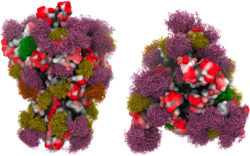As the focus turned to the new Omicron variant last week, COVID-19 data for Clarke County from the Georgia Department of Public Health continued to show a steady seven-day running average of approximately seven new cases a day, with no new deaths and just seven new hospitalizations in the last two weeks.
Data often lags behind real time transmission, however, and does not yet show any potential impacts from the Thanksgiving holiday, but UGA professor Erin Lipp’s wastewater data, which provides a snapshot of viral shedding closer to real time, suggested that community transmission is once again on the rise. The lab’s Dec. 3 update said that the “viral load this week continued in an upward trend” and “the continued increase in wastewater loads suggests that transmission is likely increasing in our area.”
To date, there have been 17,689 confirmed COVID-19 cases in Clarke County, with 108 new cases added in the last two weeks. In total, 798 Athens residents have been hospitalized for COVID-19, and 178 residents have died from the virus.
Regionally, COVID-19 patients now make up just 5.9% of all patients in Athens hospitals, with 34 hospitalized patients from Athens and surrounding counties, according to the Georgia Medical Facility Patient Census. With 65 patients in ICU beds, the region is at 92.9% of ICU bed capacity. Hospitals also saw an increase in non-COVID patients in recent weeks, with 591 inpatient beds, or 86%, in use.
With the emergence of the new Omicron variant and the holiday season in full swing, public health officials are encouraging everyone to get vaccinated, if they haven’t already, and to seek out a booster dose to help ward off potential spread in the weeks ahead. While much is still unknown about this new variant that has caused a wave of infections in South Africa, the variant has already been found in 20 countries, including Europe and the United States. Early data from South Africa suggests increased transmissibility, but the data is not yet sufficient enough to tell us if it’s more virulent. The variant, which has as many as 32 mutations to the spike protein, has worried researchers and health experts because we don’t yet know if current vaccines are as effective against this variant, especially if a community or area already has low vaccination rates.
On Friday, GDPH announced the first recognized case in Georgia. A Georgia resident, currently in New Jersey after spending two days in Georgia, tested positive for the variant after traveling from South Africa. The individual was fully vaccinated and is isolating in New Jersey. As of Dec. 3, no additional Omicron cases in Georgia had been identified.
“Vaccination and boosters are key to preventing further transmission of COVID-19 and help prevent new variants like Omicron from emerging,” DPH Commissioner Kathleen Toomey said in a news release. “Only 51% of Georgians are fully vaccinated, and of those individuals, less than 20% have received booster doses.” Beyond boosters and vaccination, the public is encouraged to continue a layered approach, with masks and social distancing, in an effort to keep the virus from spreading.
As of Dec. 3, 63,402, or 50%, of Clarke County residents have received at least one dose of a vaccine, with an increase of 674 in the last two weeks. Just 57,732 Clarke County residents, or 46%, have been fully vaccinated, with 800 fully vaccinated since Nov. 19.
Georgia DPH’s data for pediatric vaccinations, children ages 5-11, continues to stratify the data in a way that doesn’t give a full picture. As of Dec. 3, 1,018 Clarke County children ages 5-9, or 17.6%, had received at least one dose of the vaccine, with 241 new pediatric vaccines added in the last two weeks. In the 10-14 age category, 2,376 children, or 39.5%, had received at least one dose, with 141 new vaccinations in the last two weeks, but the data is skewed because children ages 12-14, who were eligible for the vaccine months ago, were also included.
Two requests for data that only includes children ages 5-11, via the DPH Data Portal, have gone unanswered to date. Further attempts at clarification about data for additional doses and booster doses, which is thus far not reflected on the DPH vaccine dashboard, have gone unanswered.
Like what you just read? Support Flagpole by making a donation today. Every dollar you give helps fund our ongoing mission to provide Athens with quality, independent journalism.










